
Features
Herbicides
Seed & Chemical
New herbicide options for Western Canada
Tired of the same old herbicide chemistries? Now two Group 14 herbicides, sulfentrazone and carfentrazone, are available for western Canadian farmers.
February 24, 2009 By Carolyn King
Tired of the same old herbicide chemistries? Now two Group 14 herbicides, sulfentrazone and carfentrazone, are available for western Canadian farmers. Growers of pulse crops and other low acreage broadleaf crops with certain hard-to-control broadleaf weeds may be especially interested in these two herbicides. The majority of herbicide use in western Canada is limited to Groups 1, 2, 4, 6 and 9. “It’s been a number of years since we’ve seen the introduction of some different modes of action into western Canada.
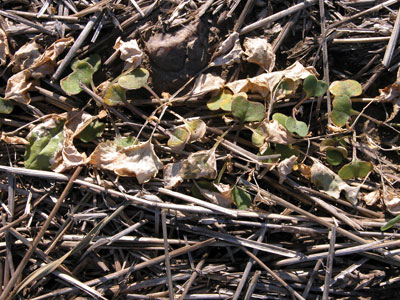 |
||
| Carfentrazone symptoms on volunteer canola All photos courtesy of Eric Johnson, Agriculture and Agri-Food Canada.
|
||
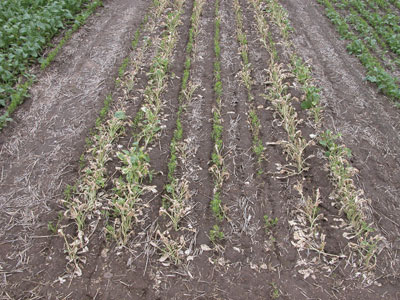 |
||
| Dead canola plants from carfentrazone application applied prior to lentil emergence Advertisement
|
That has led to some over-use of some herbicide groups,” says Eric Johnson, a weed biologist with Agriculture and Agri-Food Canada (AAFC) at Scott, Saskatchewan. “In grass weeds, for example, the Group 1 herbicides have been used quite extensively. And for broadleaf weeds we’ve used Group 2 herbicides quite extensively. In both those cases we are starting to see the emergence of resistant weeds. “If you rely on herbicides with the same mode of action too frequently, then weeds resistant to that mode of action will be selected for,” he explains. “The more herbicide options with different modes of action that people have for dealing with weeds, the easier it is to manage herbicide resistance issues.”The Group 14 herbicides inhibit the protoporphyrinogen oxidase (PPO) enzyme, which is important in the production of chlorophyll. This mode of action disrupts plant cellular membranes, causing cell leakage and desiccation of tissues. Germinating weed seedlings take up the herbicide from the soil solution.
Sulfentrazone and carfentrazone are registered in the US for various uses, but are new to Western Canada. AAFC and the University of Saskatchewan conducted screening and research on both herbicides in Saskatchewan and Alberta in recent years, and provided data that supported the recent registrations of both products.
Sulfentrazone
Sulfentrazone was introduced in Western Canada in 2008, and is marketed by NuFarm under the trade name Authority. It is a pre-seeding/pre-emergent, soil-applied herbicide for broadleaf weeds. It is used as a tank-mix with glyphosate. Sulfentrazone needs some moisture in the soil to be activated and allow root uptake, and then it provides season-long control of emerging weeds.As of late 2008, sulfentrazone has several restrictions on its use. “It has a conditional registration through the Pest Management Regulatory Agency. The company has to supply more data before it will be granted a full registration. Until PMRA gets more data, it has put a number of restrictions on sulfentrazone,” says Johnson. “The major restriction is that it’s only registered for chickpea in southern Saskatchewan. We have tested it on other crops and there is potential to use it on other crops, but chickpea had so few herbicide options that it was important to get sulfentrazone registered on chickpea. Its other restrictions are related to recropping. At present it has a very narrow list of crops that can be recropped the year following application. That is basically again just a lack of sufficient data for the Pest Management Regulatory Agency to be confident to add other crops to the label.” So far most of the Canadian data for sulfentrazone has been generated by AAFC at Scott and Lethbridge and by the University of Saskatchewan. NuFarm is now working on getting some broader data from a number of locations. The label could eventually include use on other crops beyond chickpea. AAFC’s tests showed that sunflower, flax, field pea and fababean also appeared to be tolerant to sulfentrazone. Crop tolerance to the herbicide varies with soil type and moisture conditions; above-normal rainfall can increase crop injury.A typical use for sulfentrazone would be in chickpea with a kochia problem, and then wheat following chickpea. Johnson says, “I’m sure most chickpea growers will tell you that kochia is probably their main weed problem. The only broadleaf herbicide that is registered on chickpea is Sencor, and Sencor is not particularly strong on kochia or wild buckwheat. Sulfentrazone is a very good kochia killer and it is also quite good on wild buckwheat.”
Sulfentrazone is also effective on lambs-quarters and redroot pigweed, and it can control Group 2-resistant kochia. It is not particularly strong on cruciferous weeds like wild mustard and stinkweed.
For recropping options, alfalfa, field corn, soybeans, sunflower, spring wheat and winter wheat may be seeded following one winter after sulfentrazone application. Other crops require at least two or three winters after application (see the label for details). Lentils are very sensitive to damage from sulfentrazone residues.
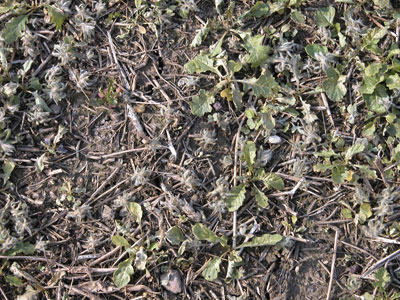 |
|
| A. Saflufenacil tank-mixed with glyphosate, four days after treatment | |
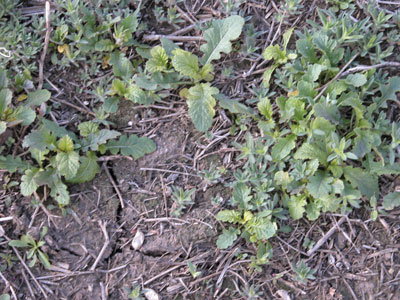 |
|
| B. Control with glyphosate alone, applied at 0.5 litre/acre (360 g/litre formulation), four days after treatment
|
|
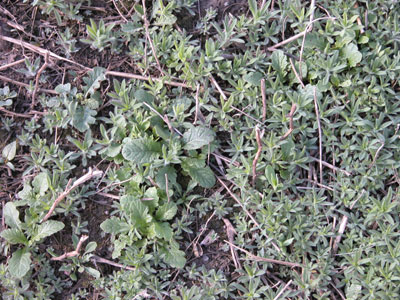 |
|
| C. Untreated check plot
|
Carfentrazone
Carfentrazone was introduced to Western Canada in 2007. It is marketed by NuFarm as CleanStart, which is a mix of glyphosate and carfentrazone. It is a pre-seeding or pre-emergence, non-residual burnoff product. It has no recropping restrictions. “Carfentrazone is used to burn down weeds very quickly, so it helps control weeds that are not that easily controlled by the glyphosate itself. For example, it helps control wild buckwheat and all types of volunteer canola,” says Johnson. “There are a number of other tank-mix partners for glyphosate, but quite a few leave a residue. Carfentrazone doesn’t leave any residue so it can be used prior to just about any crop without any fear of damaging the crop once it emerges.”
A typical fit for carfentrazone would be in spring burnoff prior to a pulse crop in a field with weed problems that include Roundup Ready or other herbicide-tolerant canola volunteers.
Johnson notes one key factor for its use: “Carfentrazone has to be applied very early, especially to weeds like volunteer canola. If it gets beyond the four-leaf stage some weeds become quite tolerant to carfentrazone so control won’t be as good.”
Another Group 14 herbicide in the testing phase
More Group 14 herbicides could be available in western Canada in the future. Johnson is involved in AAFC’s testing of a new Group 14 product from BASF, and he has also conducted a small preliminary experiment to look at the potential of another experimental compound. “We have done a fair amount of work with the new Group 14 product from BASF. It will hopefully be registered for 2009,” he says. The active ingredient is saflufenacil, and the product is used in combination with glyphosate to help burn down
broadleaf weeds.
Like carfentrazone, saflufenacil kills weeds at a much faster rate than glyphosate alone. Johnson compares the two products: “Saflufenacil could have some residual properties depending on the rate. It has a fairly broad spectrum of crops that it’s safe to apply prior to emergence, but it has more restrictions than carfentrazone. For instance, crops like pea and chickpea are quite tolerant of it, so it could be used before those crops. As well, it seems that saflufenacil can be effective over a wider range of weed growth stages
than carfentrazone.”
Johnson notes, “Saflufenacil’s development was based on the emerging issues in the United States and other parts of the world with glyphosate-resistant weeds, and the need to have partners to tank mix with glyphosate. We haven’t really identified any glyphosate-resistant weeds in Canada yet, so the use pattern here would be for burnoff to control weeds like volunteer Roundup Ready canola and other weeds that glyphosate has difficulty in controlling.